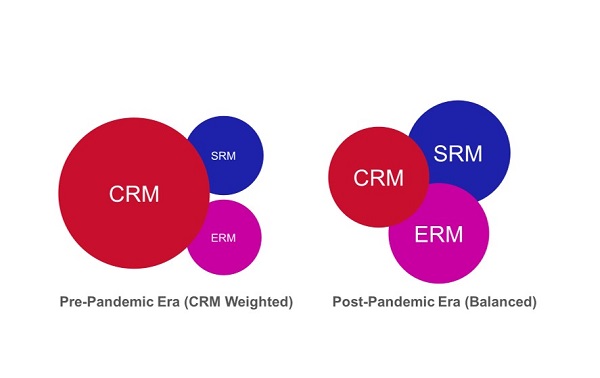A new era of growth will be supported by a new focus on supplier relationship management
太多的组织学习的the impact of ignoring enterprise-wide supplier relationships

Editor’s note: The column below is from Len DeCandia, the former global CPO at J&J. You can clickhereto read an interview with DeCandia.
The financial crisis of 2009 had two measurable outcomes on business strategy. First, it led companies to increase their focus on better P&L outcomes to satisfy a more demanding and conservative investor market. Second, it highlighted the need to meet the more immediate and customized needs of consumers, brought to the forefront through massive technological innovation.
These strategies converged to create an environment where business growth has been centered on the overall customer experience, beyond the product or service provided, particularly where the expansion of delivery channels with post-use influence are foundational contributors to competitive growth. This has resulted in significant investments in customer engagement such as customer relationship management (CRM) and other customer support tools over the past decade, often at the expense of investments in and for other critical people assets: Employees and suppliers.
这是不足为奇的CRM实践和中欧ology tools represent the biggest software market in the world, and its growth isn’t slowing down. CRM investments supported by the evolving cloud environment are now expected to reach more than $80 billion in revenues by the year 2025. The over index on CRM has created a business environment that has commoditized the other two critical business relationships: employee relationship management (ERM) and supplier relationship management (SRM). It has taken a significant, disruptive crisis with severe impacts on critical business operations and outcomes to highlight the risky nature of this tradeoff.
As we navigate through the later phases of the COVID-19 pandemic and changing marketplace, it has become clear that the role of the Human Resources function will change; so too must the role of the Procurement function and our supply management practices. As supply has become the greatest risk to growth, we must also recognize that it represents the greatest opportunity for growth.
The company that can provide quality products and services that their competitors cannot will ultimately be the winner. The ability to do this relies on both employees (having enough, qualified talent) and suppliers (relationships where they are the partner of choice). Boards have come to recognize the immediate need to reshape and reframe their relationships with employees, as well as the greater need to run their supply chains differently to effectively compete and win in this evolving era (Figure1).
Figure 1

Source: Len DeCandia
Achieving this organizational performance and growth will require advanced practices and a larger investment in both ERM and SRM, bringing them back into balance with CRM. Organizations that will win in this new era are advancing the people-management skills of their leaders, while also expanding their competencies in SRM, leading to a distinct competitive advantage.
Fundamentally, leaders are given two resources to execute their plans: people resources and budgetary resources. Procurement teams who can elevate the overall organization’s performance in SRM will represent a distinct competitive advantage for those enlightened organizations that have realized through experience that we are in a new era where supply is the greatest risk – or opportunity –for growth.
The historical perspective
这种观点的流行后是一个伟大的时代transformation. We expect the next decade to bring great social change through technological advances accelerated by the pandemic experience. Organizations will need to be more thoughtful and purposeful in deciding which capabilities should be internal versus those that can be complemented through external relationships and supplier capabilities, amid the influences of geopolitical dynamics and flexible work arrangements.
Investments in employee development and external tools and supplier management capabilities should support those decisions. Over the past twenty-five years of my CSO and CPO experiences across four Fortune 100 companies, I have seen a significant shift from internal capability optimization to a broader and deeper investment in supplier relationships for better execution across all functions. Customer driven needs for agility, speed and unique solutions have expanded the use of third-party capabilities for many organizations, elevating the importance of managing these relationships. Today, the reality is that increased external collaboration and investment for many organizations has expanded into other business-critical functions such as R&D, IT and Sales/Marketing.
Advanced organizations that are winning and thriving through the pandemic are those that have recognized the need to elevate the value of supplier relationship practices throughout the enterprise and support those relationships with digital technology. The care and investment in their employee base require a strategic integration with the investments in supplier relationships.
The supply or “supply chain” challenges discussed on every investor call these days validates its importance. This is true for all areas of organizational spend across the company, embracing a true end-to-end perspective that fully aligns the customer experience to the supplier experience. Partnering and external collaboration excellence includes deeper supplier engagement from the point of identifying an unmet customer need through design, development, commercialization, and ongoing execution of solutions. Procurement’s place in the organizational structure is of equal concern to the expansion of needed competencies to leverage these practices for business growth and competitive advantage.
Macro risk complexities
As the complexities of managing a global network of customers and suppliers have evolved along with ESG expectations, the influence and impact of the macro risk environment has expanded. The global pandemic and the challenges of coordinating activities in multiple markets experiencing unique wave cycles and government policies were a humbling education. Beyond the priority of protecting employees, the health and welfare of suppliers (as well as their employees and their suppliers) are foundational to achieving business objectives and goals.
Expanding ESG practices and investment in long term strategies is an absolute requirement in a business environment that is working to balance multiple stakeholders: customers, employees, communities and investors. For example, we must work faster to transition away from fossil fuels towards greener renewables. Ultimately, as we continue to invest in climate improvement, we are still at the mercy of the vast unpredictability of severe weather patterns that can be quite disruptive.
The further unpredictability of the geo-political environment is yet another layer of risk, leading many companies to actively investigate supplier networks, locations and exposure. Procurement teams must shape a supplier base that includes practices beyond monitoring sustainability activities, such as full transparency with defined and clear social responsibility standards in areas such as human rights and ethical business practices.
Practice made simple
The reality of any organization’s supply base is that only a small percentage of suppliers represent the majority of the overall spend profile. Managing overall supply requires an understanding of the entire supplier base defining the unique differentiating value and risk contribution of each supplier beyond the individual spend profiles.
This complex network of relationships requires a structured approach to engagement practices, aligned with the total value and risk associated with each individual supplier. These might include the suppliers’ innovation, sustainability and social impact. Procurement plays a critical role in shaping the organization’s supplier base through deep partnering with internal stakeholders who have responsibility for both the budget and the business outcomes associated with successful supplier partnering.
Coming out of the pandemic, business leaders face a more difficult environment than ever, and those that rebalance their investments across customers, employees and their relationships with suppliers will be the winners. Procurement’s value today and in the future will be measured by their ability to create an external supplier business environment supported by a real time digital infrastructure, enabling fast, easy access to the approved and vetted supplier base for the internal budget owners.
Success is achieved by creating simplicity through well-defined and governed buying channels, where immediate internal employee needs can be satisfied with the optimal supplier. The real pivot is moving the procurement or buying function from a transactional partner (“Get me the best price!”) to a more strategic partner (“Help me build a network of suppliers that drive value”). More importantly, procurement’s main role is to elevate overall organizational competencies in SRM throughout the entire engagement cycle, unleashing and fully leveraging the strategic value of the supplier base across the entire enterprise.
Leadership perspectives
在未流行时期,董事会级别的评论supply chain and the supplier environment were few and infrequent. Most organizations focused solely on cost management strategies, with additional ad-hoc activity in emergency disruption reviews.
The convergence of several significant disruptors - customer digital evolution, the global pandemic, the pivot towards greater ESG responsibilities and the unpredictability of the global macro environment - has elevated the importance of strong external management competencies in supply management at all levels of the organization.
Successful leaders in supply management and procurement will need to deliver value in three dimensions, adding innovation and ESG to cost management. The best and most valued supply management leaders in this digital era will add the ability to drive strong organization-wide competencies and practices to source, and curate and execute innovation with excellence at speed and scale.
They will advance the organization’s digital literacy and will lead external, public efforts that protect and enhance the organization’s reputation through ESG strategies that are commensurate with customer, employee base and investor expectations. Board level knowledge and expertise in supply chain management is mandatory for future-ready organizations.
Perhaps most important, investors will require greater transparency for these practices and the board must ensure that exceptional leaders are in place that can deliver growth through excellence in supplier collaboration and enterprise-wide execution.
About the author: Len DeCandia is the former chief procurement officer for Johnson & Johnson, where he spent 22 years in a variety of positions. In addition, he was CPO and a senior vice president at Estee Lauder from 2009 to 2014, and senior vice president, supply chain management at AmerisourceBergen from 2004 to 2008. DeCandia is also the founding chair of the Rutgers University Center for Supply Chain Management.

Article Topics
Latest in Logistics
Market conditions push down FTR’s Trucking Conditions Index ISM survey indicates people remain a stumbling block to procurement success Flexport announces key executive hire to run its new truckload brokerage unit POLA and POLB report April volume declines April intermodal volumes see another month of declines, reports IANA U.S. rail carload and intermodal volumes are mixed, for week ending May 13, reports AAR Transflo and Assured Telematics Inc. herald strategic merger More LogisticsSubscribe to Logistics Management Magazine

Find out what the world's most innovative companies are doing to improve productivity in their plants and distribution centers.
Start your FREE subscription today.
May 2023
万博2.0app下载

Latest Resources














